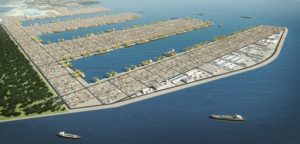
Royal Boskalis Westminster N.V. (Boskalis), a leading Dutch expert in dredging services, has secured a contract for the port development project Tuas Terminal Phase II in Singapore. According to the company’s press release, the contract worth SGD 1.46 bln (USD 1.1 bln or EUR 897 mln) was awarded by the Maritime and Port Authority of Singapore (MPA) to the consortium, which includes Boskalis, Penta Ocean Construction Company and Hyundai Engineering & Construction Company. Boskalis’ share in the consortium is 30% with a corresponding contract value of approximately EUR 300 mln.
The contract is expected to be finalized in the next few weeks after the Chinese New Year.
The Tuas mega port is the next generation container terminal currently under development in Singapore. This long-term project, targeted for completion in 2040, consists of four phases, with the Phase I construction started in April, 2017. MPA expects to open the port progressively from 2021. With the completion of the Tuas Terminal, all current Singapore container terminals at Tanjong Pagar, Pasir Panjang, Keppel and Brani, will eventually be relocated and merged at Tuas.
The Tuas Terminal is expected to be the largest container terminal in the world, with a total capacity of up to 65 mln TEU, more than the combined 50 mln TEU capacity of the current city terminals.
The Tuas Terminal Phase II development includes the design and construction of 387 hectares of land reclamation works bounded by 9.1 km of caisson walls. The 28m high caissons, each weighing up to 15,000 tonnes, are a key feature of the new port. These watertight chambers keep the water out by air pressure, allowing construction work to be carried out with ease. These concrete retaining structures, among the largest in the world, are designed as the foundation of the Tuas Terminal. Using caissons to build the wharf structure is faster than traditional methods such as piling due to the shallow sea bed. A total of 222 caissons will form the permanent wharf structure of the mega terminal, with 30 caissons already built as part of Phase I development.
Boskalis will execute various dredging and civil engineering activities, including the deepening of the port basin and access channel, dredging of a sandkey and managing the supply of sand to create the new land. The dredging and land reclamation activities will be executed with a combination of a medium-sized trailing suction hopper dredger, grab and backhoe dredgers and long-distance bulk carriers.
Boskalis will commence the construction activities in the coming weeks and expects to complete the project in 2027.
